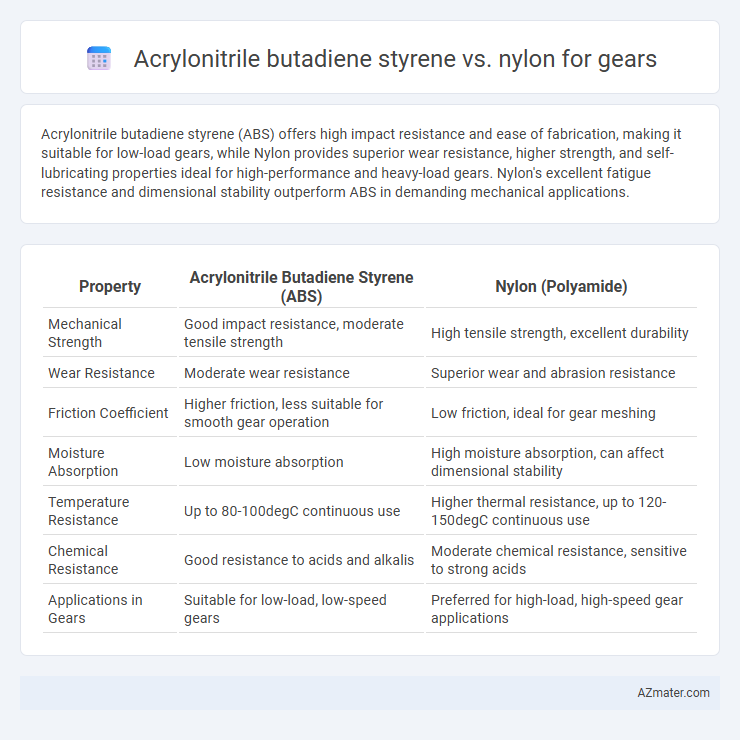Acrylonitrile butadiene styrene (ABS) offers high impact resistance and ease of fabrication, making it suitable for low-load gears, while Nylon provides superior wear resistance, higher strength, and self-lubricating properties ideal for high-performance and heavy-load gears. Nylon's excellent fatigue resistance and dimensional stability outperform ABS in demanding mechanical applications.
Table of Comparison
| Property | Acrylonitrile Butadiene Styrene (ABS) | Nylon (Polyamide) |
|---|---|---|
| Mechanical Strength | Good impact resistance, moderate tensile strength | High tensile strength, excellent durability |
| Wear Resistance | Moderate wear resistance | Superior wear and abrasion resistance |
| Friction Coefficient | Higher friction, less suitable for smooth gear operation | Low friction, ideal for gear meshing |
| Moisture Absorption | Low moisture absorption | High moisture absorption, can affect dimensional stability |
| Temperature Resistance | Up to 80-100degC continuous use | Higher thermal resistance, up to 120-150degC continuous use |
| Chemical Resistance | Good resistance to acids and alkalis | Moderate chemical resistance, sensitive to strong acids |
| Applications in Gears | Suitable for low-load, low-speed gears | Preferred for high-load, high-speed gear applications |
Introduction to Gear Materials: ABS vs Nylon
Acrylonitrile butadiene styrene (ABS) and Nylon are two popular thermoplastics used in gear manufacturing, each offering distinct mechanical advantages. ABS provides excellent impact resistance and dimensional stability, making it suitable for low to moderate stress gear applications. Nylon, with superior wear resistance and self-lubricating properties, excels in high-load, high-friction gear environments where durability and prolonged service life are critical.
Material Properties Overview: ABS and Nylon
Acrylonitrile butadiene styrene (ABS) offers high impact resistance, excellent machinability, and good dimensional stability, making it suitable for gears requiring toughness and ease of fabrication. Nylon exhibits superior wear resistance, low friction, and excellent fatigue strength, ideal for gears exposed to continuous stress and friction. Both materials provide distinct benefits, with ABS favored for lightweight applications and Nylon preferred for durability and mechanical performance in gear design.
Mechanical Strength Comparison
Acrylonitrile butadiene styrene (ABS) offers moderate tensile strength and impact resistance, making it suitable for gears requiring durability under typical load conditions. Nylon exhibits superior mechanical strength with higher tensile strength, excellent wear resistance, and better fatigue endurance, ideal for gears subjected to heavy stress and continuous operation. The fatigue resistance and self-lubricating properties of Nylon contribute to longer gear life compared to ABS in demanding mechanical applications.
Wear Resistance in Gears
Acrylonitrile butadiene styrene (ABS) offers moderate wear resistance in gears due to its good impact strength and abrasion resistance, making it suitable for low to medium-stress applications. Nylon, specifically polyamide, exhibits superior wear resistance and low friction properties, which enhance gear durability and reduce maintenance needs in high-load and high-speed environments. The choice between ABS and Nylon for gears depends on the operational demands, with Nylon preferred for wear-critical applications due to its enhanced mechanical performance and self-lubricating characteristics.
Impact and Fatigue Performance
Acrylonitrile butadiene styrene (ABS) exhibits excellent impact resistance due to its rubbery butadiene phase, making it ideal for gears subjected to sudden shocks or high-impact loads. Nylon, particularly polyamide 6 or 6/6, provides superior fatigue resistance and mechanical strength, enabling gears to withstand repeated cyclic stresses over prolonged use without significant wear or deformation. For applications demanding both high impact toughness and extended fatigue life, nylon gears typically outperform ABS, especially in environments involving continuous mechanical stress.
Thermal Stability: High-Temperature Performance
Acrylonitrile butadiene styrene (ABS) offers moderate thermal stability but begins to soften around 105degC, making it less suitable for high-temperature gear applications. Nylon exhibits superior thermal stability with a melting point above 220degC, ensuring reliable performance in gear systems exposed to elevated temperatures. Nylon's high-temperature resistance reduces deformation and wear, enhancing gear durability under thermal stress.
Chemical Resistance and Environmental Suitability
Acrylonitrile butadiene styrene (ABS) offers good chemical resistance against acids, alkalis, and oils, making it suitable for moderate exposure environments, while nylon exhibits superior resistance to a broader range of chemicals including hydrocarbons, solvents, and oils, enhancing its longevity in harsh conditions. Nylon's inherent moisture absorption can affect dimensional stability, but its excellent abrasion resistance and toughness make it ideal for gears exposed to varying humidity and mechanical stress. ABS, being more UV sensitive, is less suitable for outdoor applications, whereas nylon's better environmental resilience supports use in more variable climates and demanding industrial settings.
Machinability and 3D Printing Characteristics
Acrylonitrile butadiene styrene (ABS) offers superior machinability compared to Nylon, featuring easier cutting and shaping due to its lower melting point and less abrasive nature. In 3D printing, ABS provides better layer adhesion and dimensional stability, making it ideal for functional gears with smooth finishes and moderate mechanical strength. Nylon, while tougher and more wear-resistant, presents challenges in extrusion due to moisture sensitivity and warping, requiring controlled printing environments for optimal gear performance.
Cost and Availability Analysis
Acrylonitrile butadiene styrene (ABS) offers lower material costs and widely accessible supply chains compared to Nylon, making it a cost-effective choice for gear manufacturing. Nylon's higher raw material expenses and processing complexity increase overall production costs but provide superior mechanical strength and wear resistance. ABS availability is robust in both standard and custom formulations, while Nylon may face supply variability depending on grade and demand fluctuations.
Application Suitability: Which Gear Material Wins?
Acrylonitrile butadiene styrene (ABS) offers excellent impact resistance and ease of machining, making it suitable for lightweight gear applications with moderate stress. Nylon excels in wear resistance, self-lubrication, and tensile strength, providing superior performance in high-load, high-friction gear environments. For demanding mechanical applications, Nylon typically outperforms ABS in durability and longevity, making it the preferred choice for gears requiring enhanced strength and abrasion resistance.

Infographic: Acrylonitrile butadiene styrene vs Nylon for Gear
 azmater.com
azmater.com